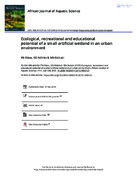| dc.description.abstract | Pertinent questions remain on whether small, artificial wetlands, such as abandoned quarries play any ecological or socio-economic role in the environment. To increase information on roles played by small-sized artificial wetlands in the environment, an assessment study was carried out in the Lily Wetland, an abandoned flooded quarry in Karura forest in Nairobi City, Kenya. This study was guided by the idea that artificial wetlands can develop over time to acquire ecological characteristics similar to those of natural wetlands. Ecological information was collected on water physico-chemical characteristics, vegetation, birds and macroinvertebrates, whereas questionnaires were administered to assess recreational and educational values of the Lily Wetland. Inspection of Google Earth maps showed that the pond has not dried in the past fifteen years, with its area remaining relatively constant between dry (0.29 ± 0.03 ha) and wet (0.36 ± 0.06 ha) seasons. Water quality of the wetland was good: pH of 7.5–7.8; dissolved oxygen = 8.73 ± 0.43 mg l−1; and clarity (Secchi disk reading) = 24.00 ± 0.43 cm. The biological component included 12 wetland plant species, 11 aquatic macroinvertebrate taxa, four species of wetland birds, and viable populations of fish and frogs. An assessment of the recreational and educational importance of the Lily Wetland, based on 34 respondents showed that 24 of the respondents visited Karura forest for recreational purposes, whereas 10 were there for educational purposes. Further analyses between the different benefits showed that the value of the forest, walking trails and wetland were significantly ranked important, when compared with the value placed on playing in fields and visiting the restaurants. Specifically, the Lily Wetland was regarded as important, because of its scenery, nature and recreational attributes. This study concluded that the Lily Wetland and other small wetlands in the urban environments have potential for recreational and educational use as in situ laboratories and demonstration centers, where benefits of conserving urban biodiversity can be communicated | en_US |
